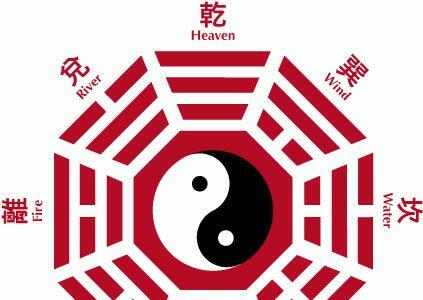The Eight Trigrams of Bagua (八卦) are eight symbols used in Taoist cosmology to understand the organization of life and the universe, and the many phenomena that occur. It is a system for organizing and understanding the forces of nature and represents the fundamental principles of reality, seen as a range of eight interrelated concepts.
There are two types of Bagua symbols: the Early Heaven and the Later Heaven. Both Baguas are associated with the eight compass or cardinal directions. The cardinal directions are determined by the marker stars of the mega-constellations known as the Four Celestial Animals:
| Direction | Celestial Animal | Season |
| East | Bluegreen Dragon | Spring equinox |
| South | Red Bird | Summer solstice |
| West | White Tiger | Autumn equinox |
| North | Dark (Mysterious) Turtle | Winter solstice |
The elements of the eight trigrams of Bagua
Each Bagua symbol consists of three lines, each line either “broken” or “unbroken,” respectively representing yin or yang. The basic idea of yin and yang consists of two natural, complementary, and contradictory forces of any phenomena in our universe, the principle of opposite polarity and duality. All forces in the universe can be classified as yin or yang energy.
Due to their tripartite structure, the Bagua symbol is called the Eight Trigrams of Bagua. The trigrams are related to Taiji philosophy, Taijiquan, and Wu Xing, or the five elements.
The five elements of Wu Xing are used extensively by feng shui and traditional Chinese medicine (TCM) practitioners. Those five elements are Water, Wood, Fire, Earth, and Metal.
The Water (Kan) and Fire (Li) trigrams correspond directly with the Water and Fire elements. The element of Earth corresponds with both the trigrams of Earth (Kun) and Mountain (Gen). The element of Wood corresponds with the trigrams of Wind (Xun) (as a gentle but inexorable force that can erode and penetrate stone) and Thunder (Zhen). The element of Metal corresponds with the trigrams of Heaven (Qian) and Lake or Marsh (Dui).
These elements have heavily influenced the development of Chinese martial arts, relationships, fortune-telling, feng shui, medicine, literature, religion, architecture, and philosophy to this day.
The construction of the eight trigrams of Bagua
Each trigram consists of a combination of three lines. Each of these lines is either a broken line, representing yin, or an unbroken line, representing yang.

From yin and yang, the next four images or “energies” are constantly moving and influencing each other, creating young yin, old yang, young yang, young yin, and old yin.

As yin and yang are applicable to all forces of nature, the theory can be applied to the moon and its phases.
The full moon is characterized by old yang. The moon’s decline through the phases to the first quarter is characterized by young yang. When there is a full moon, it’s characterized by old yin. The last quarter of the moon is characterized by young yin.
So it is with the directions: from South (characterized by old yang) to West (characterized by young yang), to North (characterized by old yin), and to East (characterized by young yin). And with the year’s seasons: from summer (characterized by old yang) to autumn (characterized by young yang), to winter (characterized by old yin), and to spring (characterized by young yin).
According to legend, after having encountered a mysterious dragon-horse on the Yellow River, the Early Heaven Bagua with its trigrams was created by Fuxi, who added a third line to the already existing four images, hence 8 possible trigrams. These eight trigrams of Bagua are Heaven, Earth, Wind, Thunder, Water, Fire, Mountain, and Lake.

- 乾 (Qián) consists of three unbroken lines. It signifies Heaven. It is all yang. For a country, it is the head of state; for a family, it is the father.
- 巽 (Xún) consists of two unbroken lines and 1 broken line. It implies the wind or sun.
- 坎 (Kǎn) consists of one broken line, one unbroken line, and one broken line. It can represent a sunken area, water, or an obstacle.
- 艮 (Gěn) consists of one unbroken line and two broken lines. It represents a mountain, and can also imply hardness or firmness.
- 坤 (Kūn) consists of three broken lines. It means earth or land. It is all yin. For a country, it is the queen; for a family, it is the mother.
- 震 (Zhèn) consists of two broken lines and one unbroken line. It implies thunder, shock, or terror.
- 離 (Lí) consists of one unbroken line, one broken line, and one unbroken line. It implies fire.
- 兌 (Duì) consists of one broken line and two unbroken lines. It represents a lake or marsh and means speech or to speak.
- Four of the eight trigrams of Bagua are considered yang, which implies masculine and positive: 乾, 震, 坎, 艮
- The other four are considered yin, implying female and negative: 坤, 巽, 離, 兌

The eight trigrams of Bagua developed from Chinese thought throughout the ages. Understanding the eight trigrams of Bagua is believed to give a person the ability to know the past, present, and future.
Follow us on Twitter, Facebook, or Pinterest

